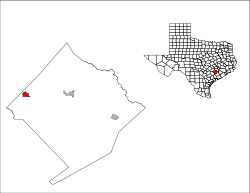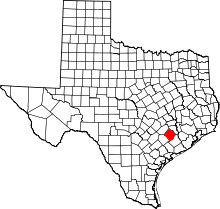Weimar, Texas
| Weimar, Texas | |
|---|---|
| City | |
 Location of Weimar, Texas | |
| Coordinates: 29°42′8″N 96°46′48″W / 29.70222°N 96.78000°WCoordinates: 29°42′8″N 96°46′48″W / 29.70222°N 96.78000°W | |
| Country | United States |
| State | Texas |
| County | Colorado |
| Government | |
| • Mayor | Bennie Kosler |
| Area | |
| • Total | 2.3 sq mi (5.8 km2) |
| • Land | 2.3 sq mi (5.8 km2) |
| • Water | 0.0 sq mi (0.0 km2) |
| Elevation | 410 ft (125 m) |
| Population (2000) | |
| • Total | 1,981 |
| • Density | 877.2/sq mi (338.7/km2) |
| Time zone | Central (CST) (UTC-6) |
| • Summer (DST) | CDT (UTC-5) |
| ZIP code | 78962 |
| Area code(s) | 979 |
| FIPS code | 48-77020[1] |
| GNIS feature ID | 1349609[2] |
| Website | weimartexas.org |
Weimar is a city in Colorado County, Texas, United States. The population was 2,181 at the 2010 census.
In 1873 the town was founded as Jackson, but subsequently called Weimar in tribute to the German city of Weimar.[3]
Located on Interstate 10 and US 90 between San Antonio, Austin, and Houston, Weimar is a small community of predominately Czech and German descendants.
Weimar is famous for Kasper's sausage, which draws a crowd every Saturday to Kasper's Meat Market in downtown Weimar.
There is also a strong history of baseball in Weimar. The Veterans Park (Strickland Field) was ahead of its time when it was built in 1948, and was the first lighted baseball field between San Antonio and Houston. The Veterans Park remains a state-of-the-art baseball stadium, having hosted a Babe Ruth League World Series Tournament in 2005.[4]
Weimar was the place where Norman J. Sirnic and Karen Sirnic were murdered by serial killer Angel Maturino Resendiz on May 2, 1999. Their parsonage was adjacent to the train tracks.
History
Weimar was founded in 1873 in anticipation that the Galveston, Harrisburg and San Antonio Railway was going to build through the site. The community was first called Jackson, after D. W. Jackson, a native Georgian and area landowner who donated land for the railroad right-of-way and the townsite. The populace subsequently chose the name Weimar; an early record states that Thomas W. Peirce, who authorized Jackson to sell lots at the site, had visited Weimar, Germany, and was favorably impressed.
The Weimar post office was established in 1873. The town was incorporated in 1875. After beginning with a few hundred townspeople, Weimar had by its tenth birthday achieved a population of over 1,000. As it grew Weimar established itself as a center of trade for pecans, poultry, and dairy products. By 1877 the town was large enough to make its first city map. In 1888 Weimar witnessed the origin of the first town newspaper, The Weimar Mercury, which currently remains in publication.
Local industries include meat processing, tooling and sheet-metal works, and manufacturing of gaskets. Agriculture continues to play an important role as Weimar continues to trade in feed grain, poultry, corn, pecans, and beef. The former GH&SA railroad remains in service today as part of the Union Pacific Railroad system.[5]
Throughout the twentieth century, Weimar enjoyed a slow yet steady growth in population, increasing on an average by 250 persons every ten years. Business establishments held their numbers steady at around seventy. After a high population of 2,400 in 1976, the town declined slightly in the following decade. In 1980 the population was 2,128. In 1990 the population of Weimar was 2,052, in 2000 it was 1,981, and in 2006 it was 2,024.[5] [6]
Geography
Weimar is located at 29°42′8″N 96°46′48″W / 29.70222°N 96.78000°W (29.702348, -96.779950).[7] According to the United States Census Bureau, the city has a total area of 2.3 square miles (6.0 km2), all of it land.
Demographics
As of the census[1] of 2000, there were 1,981 people, 817 households, and 522 families residing in the city. The population density was 877.2 people per square mile (338.4/km²). There were 940 housing units at an average density of 416.3 per square mile (160.6/km²). The racial makeup of the city was 67.95% White, 21.76% African American, 0.15% Native American, 0.91% Asian, 7.67% from other races, and 1.56% from two or more races. Hispanic or Latino of any race were 14.74% of the population.
There were 817 households, of which 27.2% had children under the age of 18 living with them, 47.6% were married couples living together, 13.3% had a female householder with no husband present, and 36.0% were non-families. 33.7% of all households were made up of individuals and 20.7% had someone living alone who was 65 years of age or older. The average household size was 2.34 and the average family size was 2.99.
In the city the population was spread out with 24.5% under the age of 18, 6.1% from 18 to 24, 22.3% from 25 to 44, 22.7% from 45 to 64, and 24.4% who were 65 years of age or older. The median age was 42 years. For every 100 females there were 83.4 males. For every 100 females age 18 and over, there were 77.8 males.
The median income for a household in the city was $27,667, and the median income for a family was $42,143. Males had a median income of $31,477 versus $16,757 for females. The per capita income for the city was $16,272. About 9.0% of families and 13.2% of the population were below the poverty line, including 22.0% of those under age 18 and 14.5% of those age 65 or over.
Education
The City of Weimar is served by the Weimar Independent School District. The Weimar Independent School District consists of a kindergarten, an elementary school, a junior high school, and a high school.
Additionally, a private, Catholic school, St. Michael's, offers education for students from kindergarten through junior high.
References
- ↑ 1.0 1.1 "American FactFinder". United States Census Bureau. Retrieved 2008-01-31.
- ↑ "US Board on Geographic Names". United States Geological Survey. 2007-10-25. Retrieved 2008-01-31.
- ↑ http://www.weimartexas.org. Weimar Official Home Page: Weimar History
- ↑ http://www.weimarsports.org/Babe-Ruth/index.html weimarsports.org
- ↑ 5.0 5.1 http://www.weimartexas.org/w-history.htm Weimar History: weimartexas.org
- ↑ http://factfinder.census.gov/servlet/SAFFPopulation?_event=Search&_name=weimar&_state=04000US48&_county=weimar&_cityTown=weimar&_zip=&_sse=on&_lang=en&pctxt=fph United States Census Bureau
- ↑ "US Gazetteer files: 2010, 2000, and 1990". United States Census Bureau. 2011-02-12. Retrieved 2011-04-23.
External links
| |||||||||||||||||||||||||
